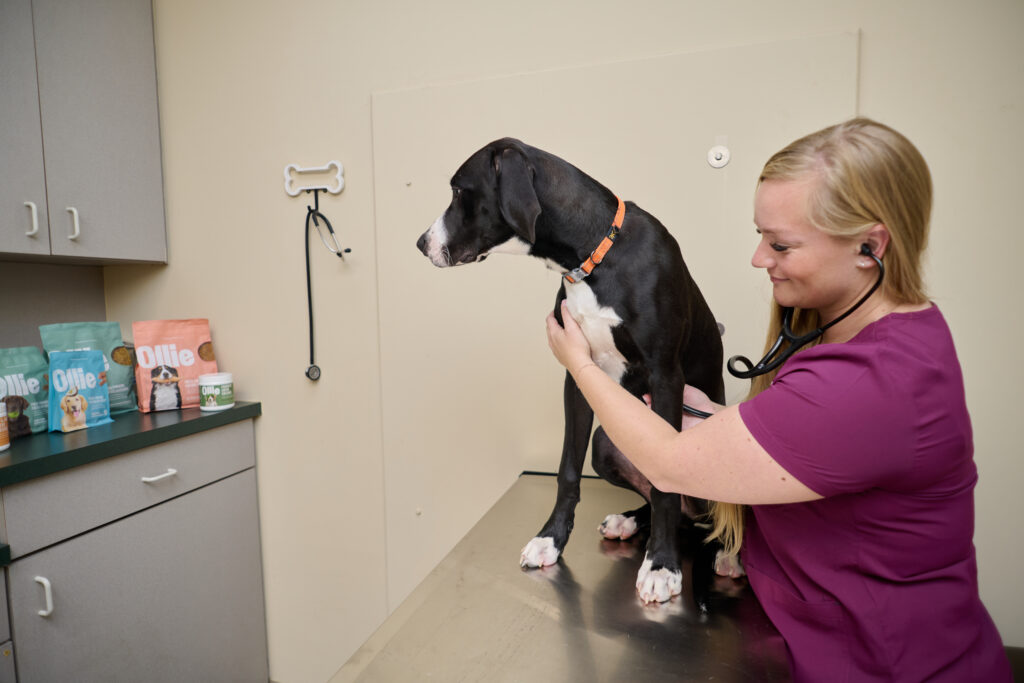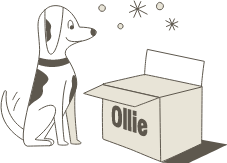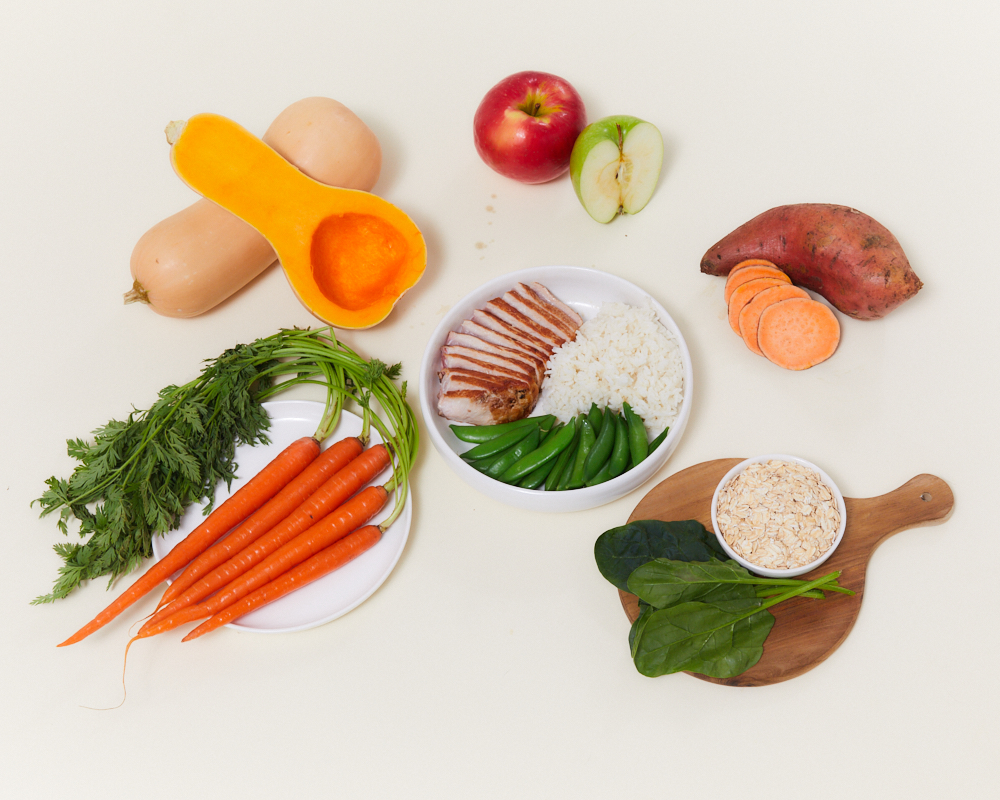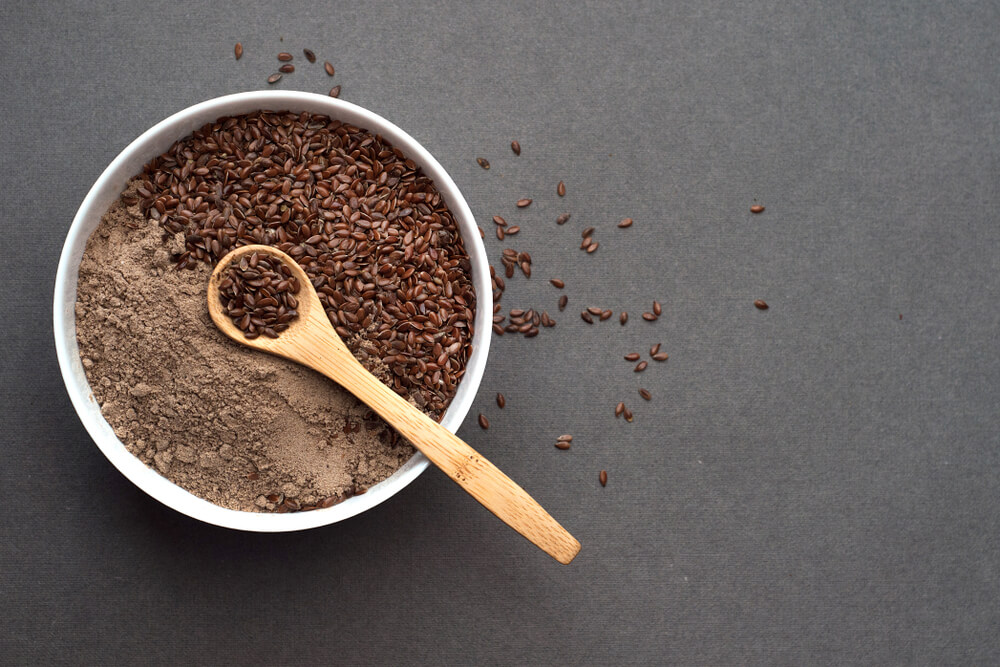Hey Ollie blog readers! We’re offering you an exclusive 60% OFF your starter box! Try now!
If your dog suffers from persistent itching, digestive upset, or recurring ear infections, you’re not alone. Only 0.2% of dogs are actually affected by food allergies [1], yet food allergy is diagnosed in up to one-fourth of dogs exhibiting allergic skin reactions [2]. For pet parents seeking relief for their dogs, understanding how human-grade ingredients can provide fast, effective allergy management is essential.
Understanding Dog Food Allergies
Food allergies in dogs occur when the antibodies react with the antigens, and symptoms occur [3] after exposure to specific ingredients. Canine food allergies, also called cutaneous adverse food reaction (CAFR), evoke a strong immune response to specific food ingredients, usually proteins or carbohydrates [2].

Common Allergy Symptoms
Symptoms of a food allergy include very itchy feet, abdomen, face, and anal area that causes the dog to scratch, chew, lick, and rub themselves [2]. Additional signs include:
- Hives, facial swelling, and itchiness to gastrointestinal signs like vomiting and diarrhea [4]
- Vomiting and diarrhea in up to 20% of food allergic dogs [5]
- Secondary infections with bacteria and yeast [5]
- Chronic ear infections and skin lesions
Most Common Food Allergens
The most common food allergens in dogs are proteins, especially those from dairy, beef, chicken, chicken eggs, soy, or wheat gluten [3]. Research shows that beef allergy in dogs occurs most often, followed by dairy and poultry [6].
Why Human-Grade Ingredients Make a Difference
Human-grade dog food represents a superior approach to managing food allergies. The ingredients used in human-grade dog food are sourced, processed, and handled in a manner consistent with the standards set for food products intended for people [7].
Key Benefits for Allergic Dogs
Feeding your pet human-grade food can provide significant health benefits, such as higher energy levels, shinier coat, healthier bowel movements, better breath and more! [8] For dogs with allergies specifically, human-grade ingredients offer:
- Stricter Quality Control: Human-grade dog food is manufactured in facilities that adhere to the strict regulations and safety standards established for producing human food
- Fewer Contaminants: Human-grade dog food often contains fewer artificial additives, preservatives, and fillers, focusing on natural ingredients [7]
- Transparency: Companies producing human-grade dog food often prioritize transparency in ingredient sourcing and labeling [7]
Specialized Diet Approaches for Allergies
Limited Ingredient Diets
Limited ingredient diets contain fewer components, making it easier to pinpoint the specific allergen [9]. These diets focus on:
- Single protein sources
- Minimal ingredient lists
- Removal of common allergens
Novel Protein Options
Novel protein diets for dogs offer several advantages, particularly for pets with allergies. These diets incorporate unique protein sources not commonly found in standard dog foods, such as kangaroo, rabbit, or crocodilia. The primary benefit is the reduced risk of allergic reactions [10].
Popular novel protein options include:
- Duck
- Venison
- Lamb
- Fish (salmon, white fish)
- Rabbit
- Kangaroo
Hydrolyzed Protein Diets
Hypoallergenic dog food, on the other hand, is made with protein that has been “split” into its basic nutrient building blocks. This “hydrolyzed” protein is usually too small to stimulate an immune response [9].
Elimination Diet Protocol
The gold standard for identifying food allergens is an elimination diet. The best and most accurate method of diagnosing a food allergy is to feed a hypoallergenic diet for 8 to 12 weeks as a food trial, called an elimination trial [3].

Steps for Success
- Veterinary Consultation: Always work with your veterinarian before starting
- Strict Adherence: It also requires that no other foods, treats, or supplements are fed during the trial period [3]
- Gradual Reintroduction: If your dog’s allergy symptoms resolve while on the food trial, the next step is to perform a food challenge by re-introducing your dog’s old food [3]
Ollie: Leading Human-Grade Allergy Solutions
Ollie delivers personalized, fresh dog food made with human-grade ingredients specifically tailored to address allergy concerns. Our recipes are formulated with veterinary nutritionists and use fresh ingredients that are prepared and packaged in human-grade facilities .
Real Success Stories
Pet parents consistently report remarkable improvements when switching to Ollie:
- He absolutely loves this food! His skin allergies have cleared up, and his coat is so soft and shiny. Ollie literally changed my dog! [11]
- After four days of eating Ollie, a wound she had about three months started to heal and has had NO recurrences since! [11]
- They used to vomit and get bad allergies from The Farmer’s Dog and it all stopped with Ollie [11]
Allergy-Friendly Recipe Options
The ingredient lists are also very simple, so you can easily select recipes that avoid certain meats that trigger allergic reactions in your dog :
- Chicken Recipe: Lowest calorie option, ideal for weight management
- Beef Recipe: Nutrient-dense with sweet potatoes
- Lamb Recipe: Great choice for dogs with food allergies or sensitivities to more commonly used proteins. It doesn’t contain any common food allergens
- Pork Recipe: Ideal if your dog is a picky eater or prone to allergies [12]
Best Practices for Managing Food Allergies
Ingredient Transparency
When selecting food for allergic dogs, read the ingredient list on the packaging of any dog food labeled as “human grade.” Look for a transparent and clear list of ingredients, and avoid products that contain artificial additives, fillers, or preservatives [7].
Cross-Contamination Concerns
Unlike veterinary diets, retail pet foods are not manufactured with the extreme health and safety protocols to prevent cross-contamination [3]. This makes human-grade options particularly important for sensitive dogs.
Gradual Transitions
Switching dog food can sometimes lead to digestive concerns, so it’s important to add a new food gradually [9]. Transition over 7-10 days by gradually increasing the new food while decreasing the old.
Long-Term Health Benefits
Beyond immediate allergy relief, human-grade ingredients support overall health:
- Another benefit is the potential for improved skin and coat health. By eliminating common allergens, novel protein diets can lead to decreased itching and inflammation, resulting in healthier skin and a shinier coat [10]
- Research has shown that fresh dog food is linked to a 20% longer lifespan [8]
- Enhanced digestibility and nutrient absorption

Take Action Today
If your dog suffers from food allergies, don’t wait for symptoms to worsen. You should always consult your veterinarian when switching your dog’s food, and this is especially important for pets with suspected allergies. If your veterinarian thinks your dog has a true food allergy, they will recommend a guided elimination diet trial to identify the specific allergen [13].
Ready to transform your pup’s health with human-grade nutrition? Take our quiz today to discover the perfect allergy-friendly recipe tailored to your dog’s specific needs. With simple recipe lists and proven results, Ollie makes managing allergies easier than ever.
Frequently Asked Questions
Q: How quickly can I expect to see improvements in my dog’s allergy symptoms?
A: Many pet parents notice improvements within days to weeks. One Ollie customer reported healing began after just four days, though complete elimination diet trials typically require 8-12 weeks for definitive results.
Q: Are human-grade ingredients really better for dogs with allergies?
A: Yes. Human-grade ingredients undergo stricter quality control, contain fewer artificial additives, and provide greater transparency in sourcing—all crucial factors for managing food allergies effectively.
Q: Can I do an elimination diet at home without veterinary supervision?
A: While you can start with limited ingredient diets, proper elimination diet trials should always be supervised by a veterinarian to ensure nutritional adequacy and accurate allergen identification.
Q: What’s the difference between food allergies and food sensitivities?
A: Food sensitivity is a chronic condition rather than an immunological response to a specific ingredient [2]. Both conditions benefit from dietary changes, but true allergies involve immune system responses requiring more careful management.
Q: How do I know if a novel protein is truly “novel” for my dog?
A: A novel protein is one your dog has never consumed before. Review your dog’s complete dietary history, including treats and supplements, to identify truly new protein sources for elimination diet trials.
Citations
[1] https://www.petmd.com/dog/conditions/digestive/food-allergies-dogs
[2] https://www.akc.org/expert-advice/nutrition/dog-food-allergies/
[3] https://vcahospitals.com/know-your-pet/food-allergies-in-dogs
[4] https://www.akc.org/expert-advice/health/dog-allergies-symptoms-treatment/
[5] https://veterinaryskinandear.com/food-allergies-in-dogs/
[6] https://www.purina.com/articles/dog/health/symptoms/how-to-identify-dog-food-allergy-symptoms
[7] https://www.whole-dog-journal.com/food/human-grade-dog-food-choices/
[8] https://be.chewy.com/what-is-human-grade-dog-food/
[10] https://holisticvetblend.com/blogs/news/how-to-make-homemade-allergy-dog-foods
[11] https://www.deliveryrank.com/reviews/ollie
[12] https://www.reviewed.com/pets/content/ollie-dog-food-review-honest-opinion-service
[13] https://www.petmd.com/dog/vet-verified/best-dog-food-for-dogs-with-allergies
Tagged As:

The nutrition your dog needs,
the food they want.

Enjoying our articles? Subscribe our Newsletters and get new articles directly to your inbox
You might also like
18 September 2025
6 MINS READ
Can Dogs Eat Flaxseed? Is Flaxseed Safe For Dogs?
Wondering if flaxseed is safe for your dog? This guide breaks down the benefits, risks, and best ways to add flaxseed, or flaxseed oil, to your pup’s diet.
18 September 2025
6 MINS READ
Why is My Dog Not Eating But Acting Normal? Causes & What To Do
Worried your dog isn’t eating but still acting normal? Here’s what could be going on and what to do to help your pup get their appetite back.
18 September 2025
5 MINS READ
Can Dogs Eat Crab? Is Crab Meat Safe For Dogs?
Thinking about giving your dog crab meat? Find out if it’s safe, what risks to watch for, and when crab might do more harm than good.







